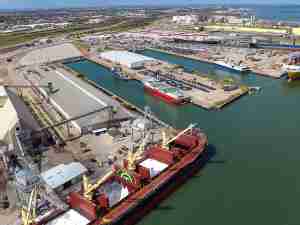Last year, a log jam of over 100 unloaded ships waiting at Brazilian ports helped to boost sugar prices to 30-year highs, since the global market faced a supply deficit of the sweetener after several producing countries saw their output reduced by bad weather.
Brazil's exports in 2011 are expected to be higher than last year's record 28 million tonnes, but with its ports operating near near capacity, tightness in the sugar market could be magnified if serious bottlenecks reoccur.
Projects to allow loading in the rain, expand storage and deepen channels won't be ready in time to streamline exports from the world's largest sugar producer in the newly-started 2011/12 season.
"Last year we had a serious problem of concentration of shipments that can happen this year again," said Julio Fontana, the president of Rumo, the logistics company of sugar giant Cosan.
"We have taken a series of steps to minimize this kind of problem. If this will be enough or not, I cannot say," he told Reuters, adding that investments by state-run firms are too slow to match the rapid growth of Brazilian exports.
The late start of the new crushing season should contribute to a concentration of shipments in few months, he added.
Brazil's largest sugar terminal operator, Rumo is expanding its loading capacity in Santos to 18 million tons by 2013 from around 11 million tonnes currently. Capacity could grow to 25 million tonnes by 2016 in a second phase.
The company is also improving warehouse space at the port and in building new storage units in the countryside, which is seen as a major bottleneck in Brazil.
But important projects are being held up.
Giant Tarpaulin
The company's plan to cover a bulk sugar terminal in Brazil's main port of Santos that would allow it to operate in rainy weather and boost capacity by 30 percent, is being delayed as it awaits government clearance. The hold up could greatly impact Brazil's capacity to ship sugar.
"The construction has been hired, we are only awaiting authorization which has been very slow," he said, adding that even if work starts now, the cover would not be finished before the next cane season that starts in April 2012.
The shield covering Rumo's Terminal Sul will be large enough for Panamax and Capesize ships which can take up to 120,000 tons of sugar.
Meanwhile the company has invested in new equipment to cover its second terminal in Santos. The tent-like canopy completely covers bulk carriers' holds individually, enabling the loading spout to move around inside the hold as the tarpaulin reels in or extends.
The project does not demand authorities' approval and allows loading in wet weather, though not under heavy rain.
"It will be a test. We bought the equipment that should become operational in May-June (2011)," Fontana said. Light rains are the most common in Santos, which had more than 100 rainy days per year over the past two years.
Investments are estimated at 55 million reais to cover each of the two terminals that in 2011/12 (April-March) should load 10-11 million tonnes of sugar, up from 8 million last season.
The volume is about twice that exported by Thailand, the world's No. 2 sugar exporter, in the whole season.
Port Logjams, Record Prices
A combination of factors led to record waits in 2010 for ships arriving to load sugar at ports in Brazil, the world's biggest exporter of the sweetener, mostly raw.
A drop in sugar prices in May last year from 30-year highs drew a rush of international buyers eager to replenish stocks, while Brazil remained as the only major supplier with available output for export.
The spike in demand coincided with persistent rains over Santos, where terminals cannot operate in wet weather. Even the lightest showers can hurt sugar quality.
"A perfect storm could happen again, espec










